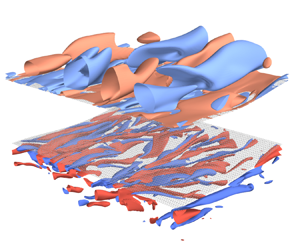Article contents
Dynamics of turbulence production by attenuating interfacial gravity waves observed in air–water coupled wave-resolving simulation
Published online by Cambridge University Press: 21 November 2024
Abstract

Even without breaking or wind influence, ocean surface waves are observed to produce turbulence in the water, possibly influencing ocean surface dynamics and air–sea interactions. Based on the water-side free-surface simulations, recent studies suggest that such turbulence is produced through the interaction between the waves and the near-surface Eulerian current associated with the viscous attenuation of waves. To clarify the dynamical role of the air–water interface in the turbulence production, the attenuating interfacial gravity waves were simulated directly using a newly developed two-phase wave-resolving numerical model. The air–water coupling enhanced the wave energy dissipation through the formation of a strong shear at the air-side viscous boundary layer. This led to an enhancement of the wave-to-current momentum transfer and the formation of the down-wave Eulerian mean sheared current, which is favourable for the CL2 instability responsible for the production of Langmuir circulations. As a result, the water-side turbulence grew stronger compared with the corresponding free surface (water-only) wave-resolving simulation. The evolution of the wave-averaged field was well reproduced with the Craik–Leibovich equation with the upper boundary condition provided with the virtual wave stress based on linear theory. The wave energy dissipation by air–water coupling plays a significant role in the quantitative understanding of the wave-induced turbulence at the laboratory and field scales.
JFM classification
Information
- Type
- JFM Papers
- Information
- Copyright
- © The Author(s), 2024. Published by Cambridge University Press
References
- 2
- Cited by


